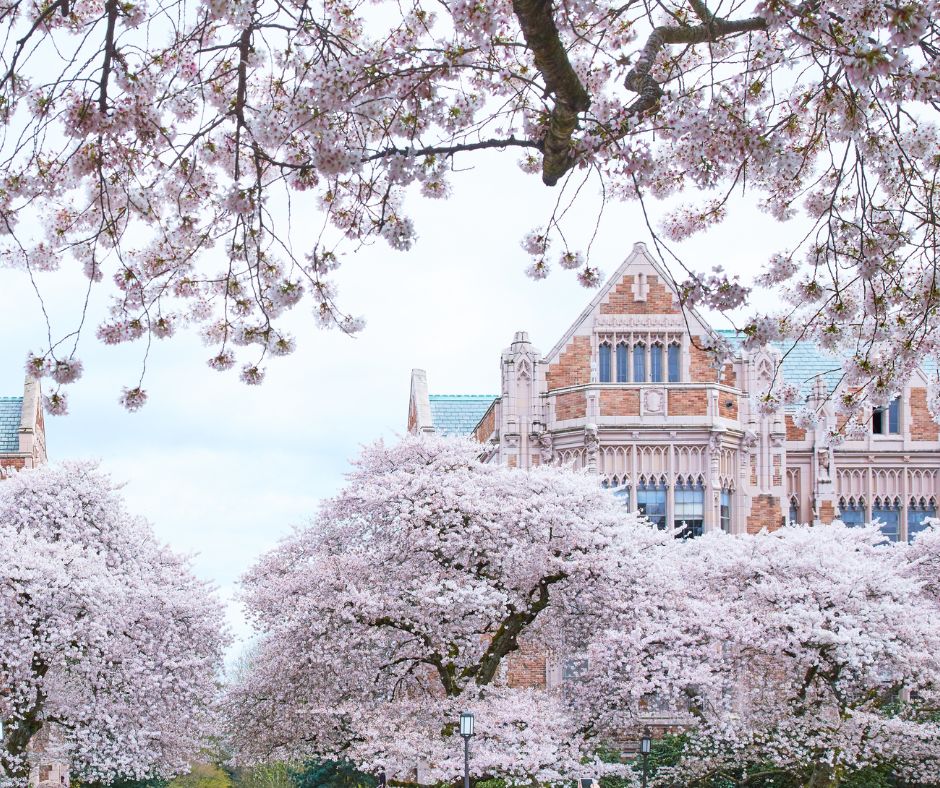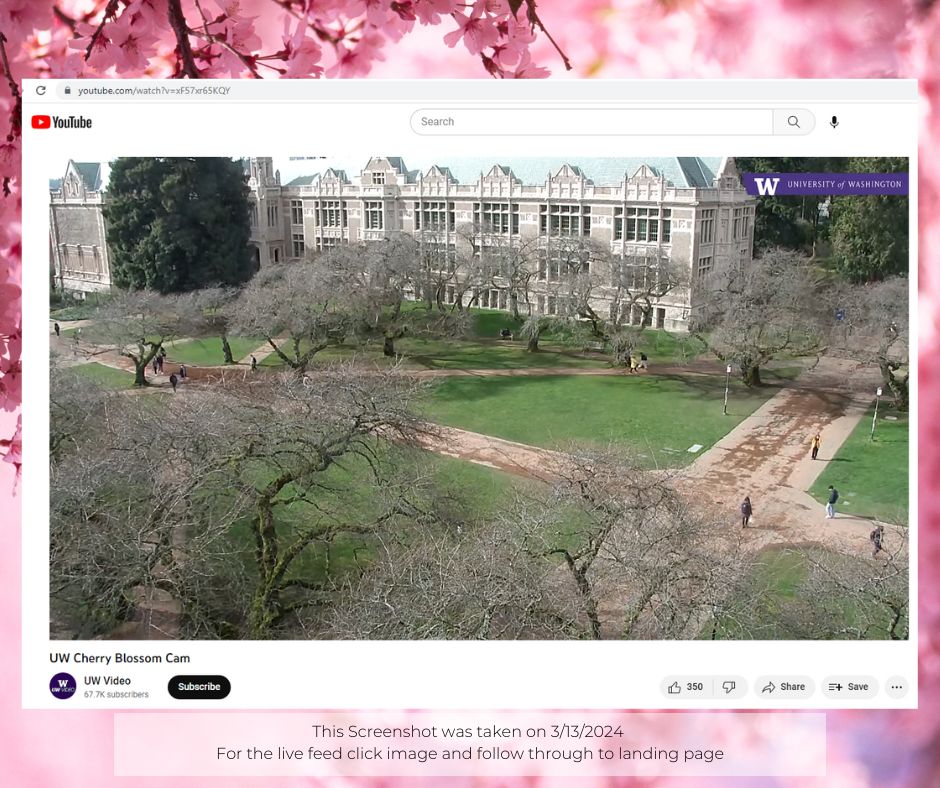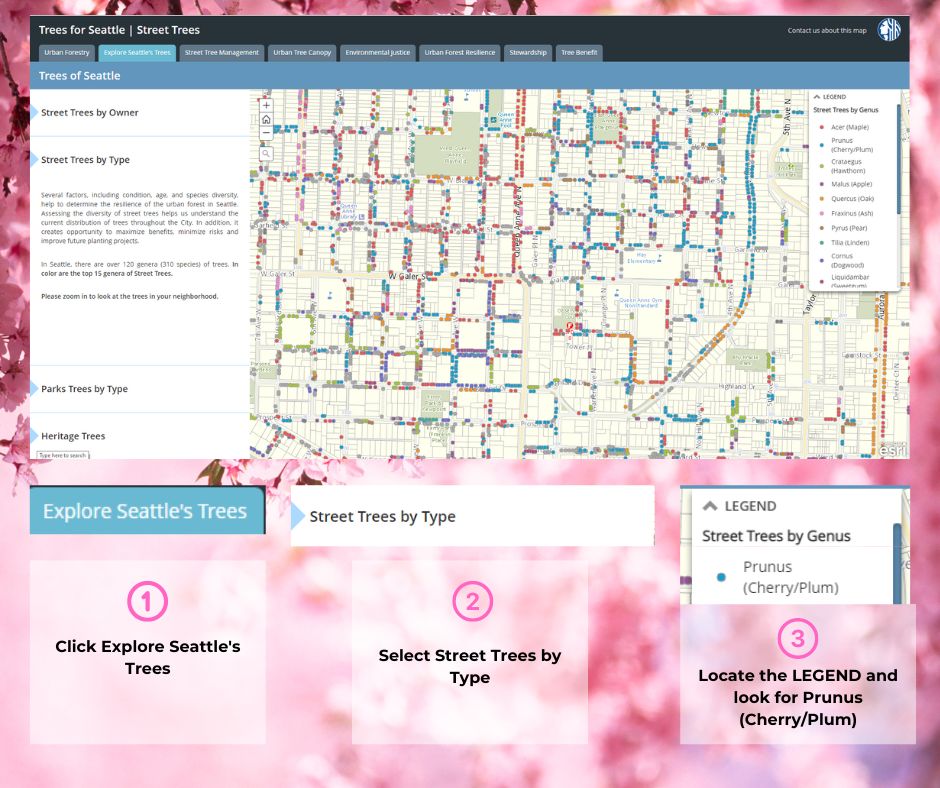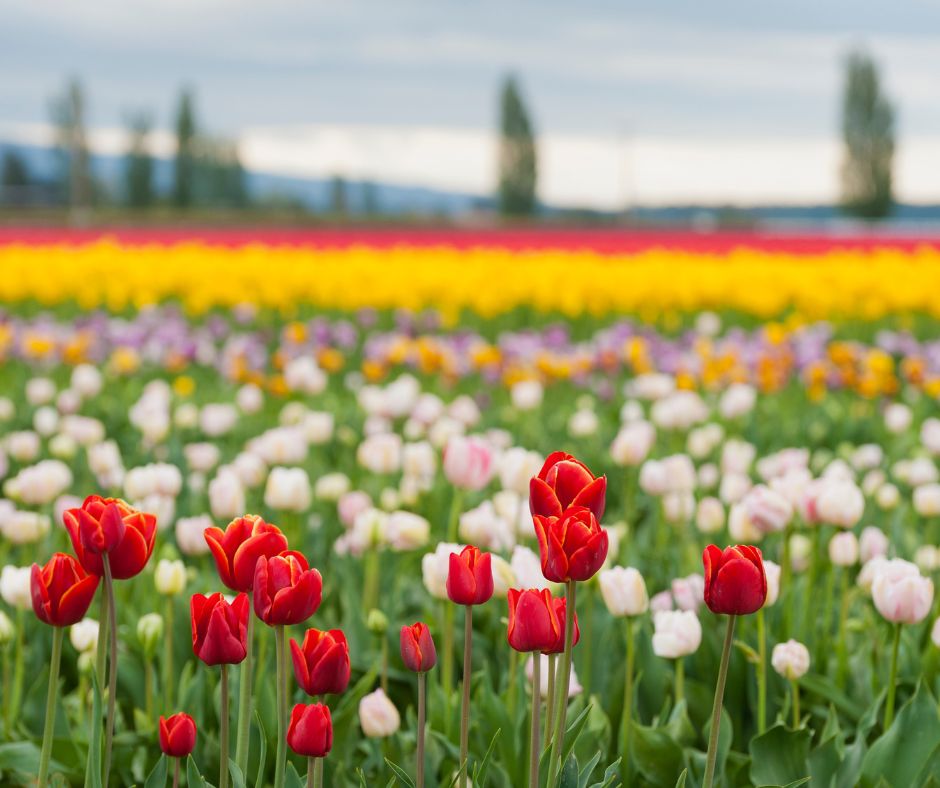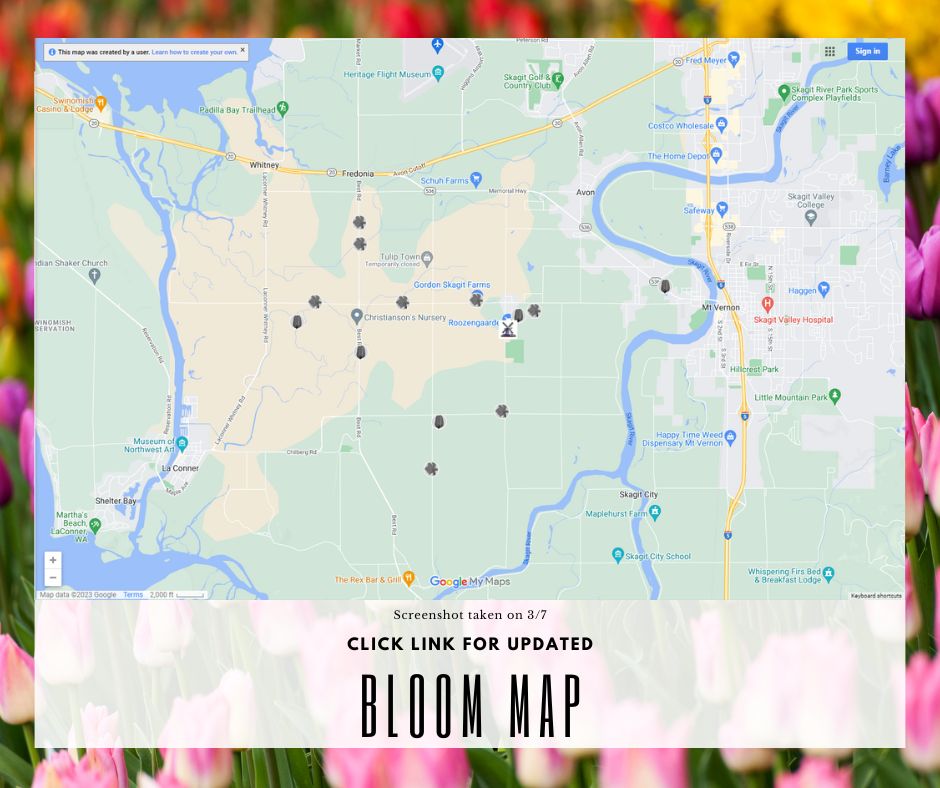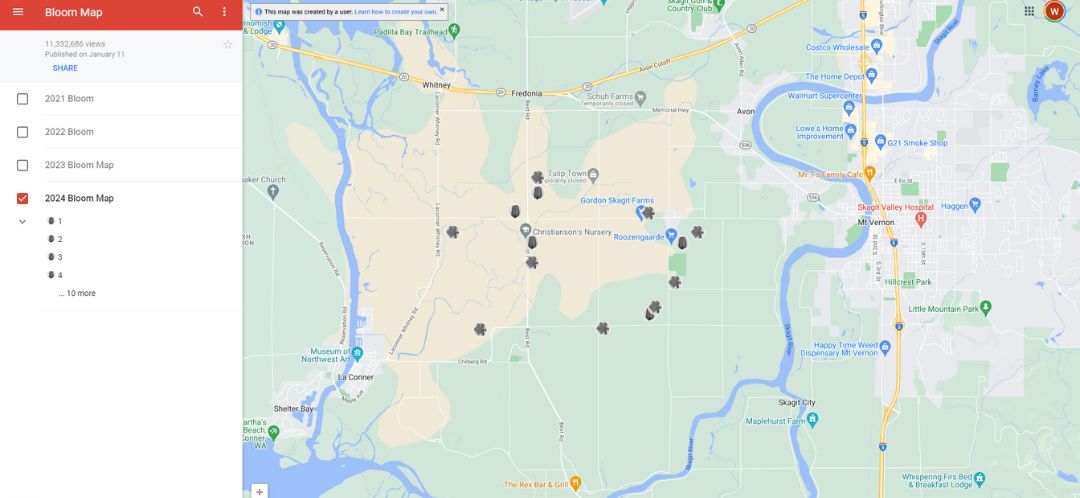Cherry Blossom Trees at the University of Washington
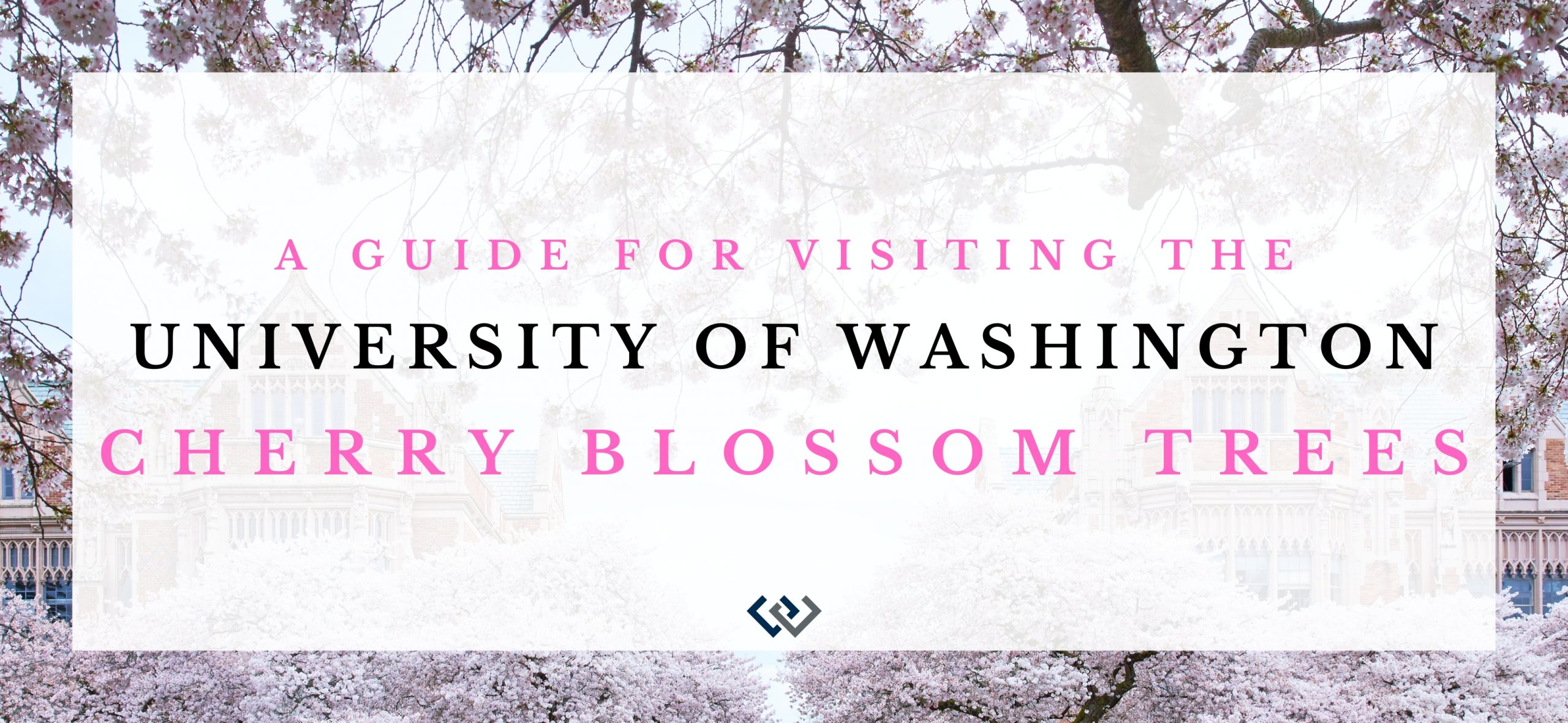
Cherry Blossom Trees at UW
Here in Washington, we have a few celebrity flowers that have blossomed their own dedicated cult following. One of these blooms even has its own Twitter account and a year-round live feed webcam. That’s right! The beauty of the Cherry Blossom Trees at the University of Washington’s quad is a renowned crowd drawer.
A Guide to Visiting the UW Cherry Blossom Trees
Explore the beauty of the University of Washington’s Cherry Blossom Trees with my guide! Learn about when and where to view the blooming flowers, the history of the trees, and tips for making the best of your visit. Unforgettable photos, magnificent memories, and a unique experience await you at the UW Cherry Blossom Trees!
When do they bloom?
The UW Cherry Blossom Trees usually start blooming in mid-March and can continue through mid-April. Typically, peak bloom happens in the third week in March, according to UW arborist Sara Shores. But the exact timing of the blooms depends on the weather, so it can vary from year to year. It’s a gorgeous sight to see the campus in full bloom, so be sure to take some time to enjoy it when it happens!
The History of The UW Cherry Blossom Trees
The true origin story of the UW Cherry Blossom Trees has been lost to time and myth. One consistent is that the trees arrived in Washington sometime in the early 1900’s. One story says they were originally planted at Washington Park Arboretum and transplanted in UW’s quad later. Another version is that they were gifted to Seattle in 1912 by the mayor of Tokyo. Either way, they’re old.
The Route to View the Blossoms
When I say these trees draw a crowd, I’m not kidding. The University of Washington offers viewers a route to get to the Cherry Blossoms.
“4/1/22 update: Traffic congestion on campus is significant during cherry blossoms season and parking is limited. Please take light rail to the University District Station or park in the Central Parking Garage or Padelford Parking Garage.”- University of Washington
Check Out UW’s Live Webcam
To Remove any guesswork, head over to UW’s live webcam to see if the flowers have opened.
Want to Try to Avoid Crowds?
There are Cherry Blossom Trees planted throughout the greater Seattle Area. The Seattle Department of Transportation created an interactive map of trees across the city. To Find the cherry trees look for the spots marked Prunus (Cherry/Plum); just be aware the trees could be a plum tree. Happy Hunting!
They Won’t Last Long So See them ASAP!
Cherry blossoms are often thought to represent many things. The beauty and fragility of life, renewal, spring, love, hope, joy, and friendship. Many of the trees gifted to Seattle by Tokyo were offered to the city as a token of friendship. They are a beautiful sight to see and they don’t last long. One year a windstorm swept them away during peak bloom. So, make sure to stay on top of their socials if you want to see them in person this year!
By Kerriann Jenkins
Skagit Valley Tulip Guide
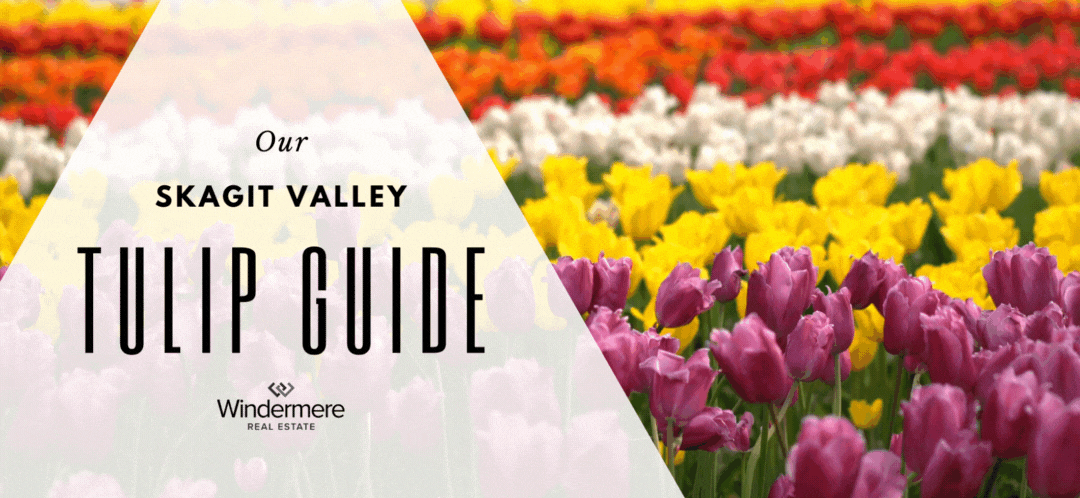
Skagit Valley Tulip Guide
The Skagit Valley Tulips have become the undisputed royalty of blooms in Washington State! It’s no wonder, given their renown – in 2016, National Geographic voted them as the number one feature in their “Best Spring Trips” and in 2019, Celia Fernandez of Oprah Magazine named them number four in her “10 Best Flower Festivals in the U.S.” list. These honors have certainly helped to cement the tulips’ reputation, but they were already drawing crowds of thousands of visitors worldwide before making these lists, and continue to do so to this day. If you’re looking for a spectacular show of blooms, there’s nothing quite like the Skagit Valley Tulips! To help make your visit to Skagit Valley a memorable one, here is a detailed Skagit Valley Tulip Guide.
What Makes The Tulips So Popular?
Just imagine a landscape quilted with rows and rows of vibrant patterns of hand tailored tulips with a picturesque snowcapped mountain range in the backdrop. It seems like something from a dream. But the reality is, every spring, acres and acres of land in Skagit Valley are blanketed with vibrant, multi-colored tulip blooms. Moreover, visitors can enjoy walking around the fields, exploring various farms, and taking pictures of the stunning views.
When is The Best Time to See the Skagit Valley Tulips?
This question is a little harder to answer. The Skagit Valley Tulip Festival runs from April 1st to April 30th each year. However, weather and field conditions will cause the tulip bloom times to fluctuate from the last week of March through the second week of April. You can verify bloom locations by viewing this Bloom Map:
Where To See the Skagit Valley Tulips?
The tulip fields are open to the public, but they are located on private land. Because of crop rotation, the tulip fields are different each year. RoozenGaarde, Tulip Town, Tulip Valley Farms, and Garden Rosalyn all have tulip displays for visitors to view and photograph. Every bulb grower has their own admission fee and set of rules to follow so make sure you head to their websites to see what the 2024 year expectations are.
Where to Stay Overnight?
The official Skagit Valley Tulip Festival website has compiled a thorough list of accommodations. In my opinion, if you are willing to travel a little, I would recommend looking at lodging in La Conner or Anacortes for something more affordable and less crowded during the tulip bloom season.
Pro Tips For Skagit Valley Tulip Tiptoeing
Layering up and making sure you have a change of clothes and shoes is essential for a successful and enjoyable tulip visit. The weather in Skagit Valley can be unpredictable, and the tulip fields can be muddy, so making sure you’re prepared is key. It’s also important to remember to not walk through the tulips as this can damage the flowers. Instead, find the perfect angle to capture your photo so that it looks like you are in the middle of the field. Lastly, bring snacks and water for the car ride! The lines to park can be a LONG wait. With these tips in mind, you’re sure to have a great tulip-tiptoeing experience.
Want More Skagit Valley Tulip Festivities?
This year’s event promises to be bigger and better than ever with over 140+ vendors, entertainers, food trucks, and children’s activities. Be sure to grab some delicious food while you’re down there and don’t forget to stop by the local shops and the Riverwalk!
A few stores I would recommend you check out are Jeka’s Plants, Forte Chocolates, and the Skagit Valley Food Co-Op.
You Will Be Happy You Went!
Skagit Valley is truly a breathtaking sight to behold each spring! The sight of acres of hand tailored flowers in vibrant and vivid colors is an image that will stay with you for a lifetime. Not only are the views stunning, but you can also explore the many nearby farms and take pictures of the incredible scenery. There is no better way to welcome in the spring season than with a visit to Skagit Valley!
Kerriann Jenkins
Washington State Daffodil Guide
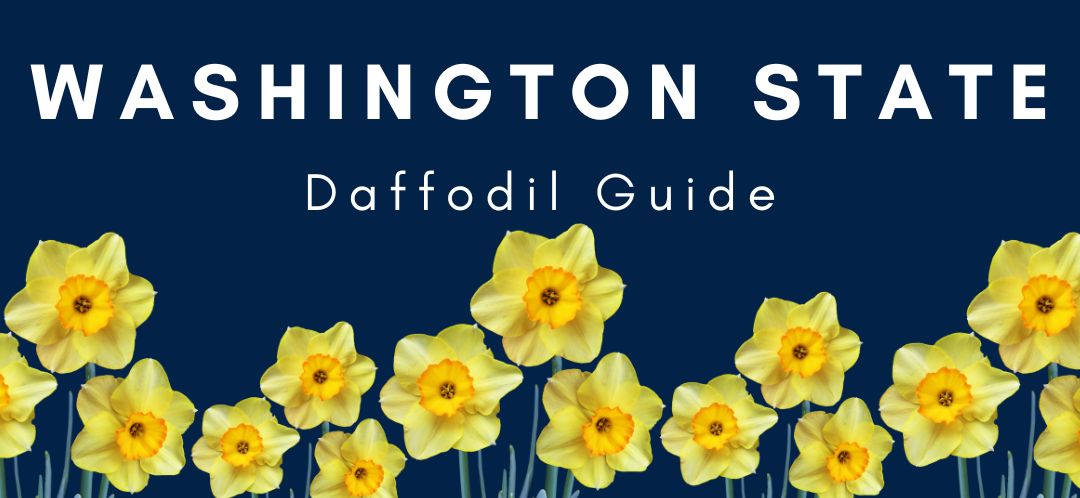
A Washington State Daffodil Guide
Washington State has a reputation for wielding moody gray skies. Given that, you may find it odd to learn that Washington is the largest supplier of daffodil bulbs and daffodil flowers in the United States. Such a sunny dispositioned flower may seem out of place here, but they thrive in Washington. Below you will find a Washington State Daffodil Guide discussing where to see them and how to grow them.
When Daffodils Begin To Bloom
Daffodils typically bloom from late winter to early spring and can last for a few weeks. If you are looking to see daffodils this bloom season, you are in luck! There are plenty of great places to find them. One of the best spots is in Skagit Valley.
Daffodils in Skagit Valley
Although Skagit Valley is known for their Tulips, they also grow around 1,000 acres of daffodil fields. These bright fields start shining while the weather is still cool in the early spring. The fields are private, which most likely explains why the daffodils don’t attract the same crowds the Tulips do.
While you can’t traipse through the fields, you can view the daffodils from the roadside. Conveniently, RoozenGaarde has an interactive bloom map you can view to see where the flowers have blossomed before embarking on your road trip.
La Conner Daffodil Festival
If you are looking for a more immersive way to see daffodils head over to the La Conner. The city holds an annual Daffodil Festival which includes a Daffodil Parade, a Daffodil Pet Parade, a Daffodil Photo Contest, and other daffodil themed delights. Check out their event page for more details.
91st Annual Daffodil Festival Grand Floral Parade
Another interactive daffodil experience can be found at the 91st Annual Daffodil Festival. This unique event is hosted by four cities. On April 6th, 2024 the parades will begin as follows: Tacoma 10:15 | Puyallup 12:45 | Sumner 2:30 | Orting 5:00. For more information visit the event page.
Grow Your Own Daffodils
Of course, there is another way to enjoy daffodils, grow your own! Planting daffodils is a great way to add a vibrant splash of color to your garden! The best time to plant daffodils is in the fall, a few weeks before the first frost, when ground temperatures are around 60-65 degrees. You’ll want to find a spot that gets plenty of sun. When planting, dig a hole a few inches wider and deeper than the bulb, with the pointed end facing up. In the right conditions a daffodil will rebloom annually. If you are looking for larger blooms, you may want to divide and replant your daffodils every three to four years, as this helps to increase the number of blooms each year. If you have a variety that is not a common one, I would recommend consulting with a local nursery or gardening expert for advice on how often to divide and replant them.
Daffodils Are The First Sign of Spring!
Daffodils are a beautiful signifier that spring is nearing. I grew up driving through the Skagit Valley area and I promise their sunlit hued faces are worth seeing, even from a respectful distance! If you are lucky, you may get to see Snow Geese taking flight over the flower fields during your visit! Have fun adding daffodils to your spring garden and activities!

 Facebook
Facebook
 X
X
 Pinterest
Pinterest
 Copy Link
Copy Link
